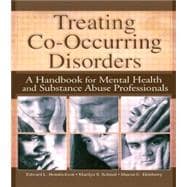
What is included with this book?
| Preface | xi | ||||
| Chapter 1. The New Reality: Multifarious Caseloads | 1 | (22) | |||
|
1 | (1) | |||
|
2 | (1) | |||
|
3 | (2) | |||
|
5 | (3) | |||
|
8 | (2) | |||
|
10 | (2) | |||
|
12 | (1) | |||
|
13 | (8) | |||
|
21 | (2) | |||
| Chapter 2. Then and Now: Concepts and Treatment of Co-Occurring Disorders | 23 | (12) | |||
|
25 | (2) | |||
|
27 | (2) | |||
|
29 | (2) | |||
|
31 | (2) | |||
|
33 | (2) | |||
| Chapter 3. Frequently Co-Occurring Axis I Psychiatric and Substance Use Disorders | 35 | (26) | |||
|
36 | (2) | |||
|
38 | (4) | |||
|
42 | (5) | |||
|
47 | (3) | |||
|
50 | (3) | |||
|
53 | (2) | |||
|
55 | (2) | |||
|
57 | (1) | |||
|
58 | (3) | |||
| Chapter 4. Personality Disorders That Frequently Co-Occur with Substance Use Disorders | 61 | (16) | |||
|
61 | (1) | |||
|
62 | (1) | |||
|
63 | (6) | |||
|
69 | (4) | |||
|
73 | (3) | |||
|
76 | (1) | |||
| Chapter 5. Assessment | 77 | (20) | |||
|
78 | (3) | |||
|
81 | (3) | |||
|
84 | (2) | |||
|
86 | (1) | |||
|
87 | (4) | |||
|
91 | (2) | |||
|
93 | (2) | |||
|
95 | (2) | |||
| Chapter 6. Introduction to Treatment: Goals and Themes | 97 | (10) | |||
|
97 | (1) | |||
|
98 | (7) | |||
|
105 | (2) | |||
| Chapter 7. Psychoeducation and Group Therapy | 107 | (22) | |||
|
107 | (1) | |||
|
108 | (1) | |||
|
109 | (1) | |||
|
110 | (3) | |||
|
113 | (1) | |||
|
113 | (1) | |||
|
114 | (1) | |||
|
115 | (2) | |||
|
117 | (6) | |||
|
123 | (3) | |||
|
126 | (1) | |||
|
127 | (1) | |||
|
127 | (2) | |||
| Chapter 8. Individual Therapy and Case Management | 129 | (14) | |||
|
129 | (4) | |||
|
133 | (2) | |||
|
135 | (3) | |||
|
138 | (2) | |||
|
140 | (2) | |||
|
142 | (1) | |||
| Chapter 9. Family Interventions | 143 | (26) | |||
|
143 | (3) | |||
|
146 | (2) | |||
|
148 | (2) | |||
|
150 | (4) | |||
|
154 | (4) | |||
|
158 | (8) | |||
|
166 | (3) | |||
| Chapter 10. Promoting Long-Term Stability: Relapse Prevention and Symptom Management | 169 | (10) | |||
|
170 | (2) | |||
|
172 | (4) | |||
|
176 | (1) | |||
|
177 | (1) | |||
|
177 | (2) | |||
| Chapter 11. Substance Abuse and Mental Health Recovery Movements | 179 | (14) | |||
|
179 | (4) | |||
|
183 | (3) | |||
|
186 | (1) | |||
|
187 | (2) | |||
|
189 | (3) | |||
|
192 | (1) | |||
| Chapter 12. Supervising Staff with Multifarious Caseloads | 193 | (16) | |||
|
193 | (3) | |||
|
196 | (5) | |||
|
201 | (6) | |||
|
207 | (2) | |||
| Chapter 13. Measuring Change: Reasonable Outcome and Performance Standards | 209 | (10) | |||
|
209 | (2) | |||
|
211 | (3) | |||
|
214 | (1) | |||
|
215 | (1) | |||
|
215 | (1) | |||
|
216 | (1) | |||
|
217 | (2) | |||
| References | 219 | (16) | |||
| Index | 235 |
The New copy of this book will include any supplemental materials advertised. Please check the title of the book to determine if it should include any access cards, study guides, lab manuals, CDs, etc.
The Used, Rental and eBook copies of this book are not guaranteed to include any supplemental materials. Typically, only the book itself is included. This is true even if the title states it includes any access cards, study guides, lab manuals, CDs, etc.